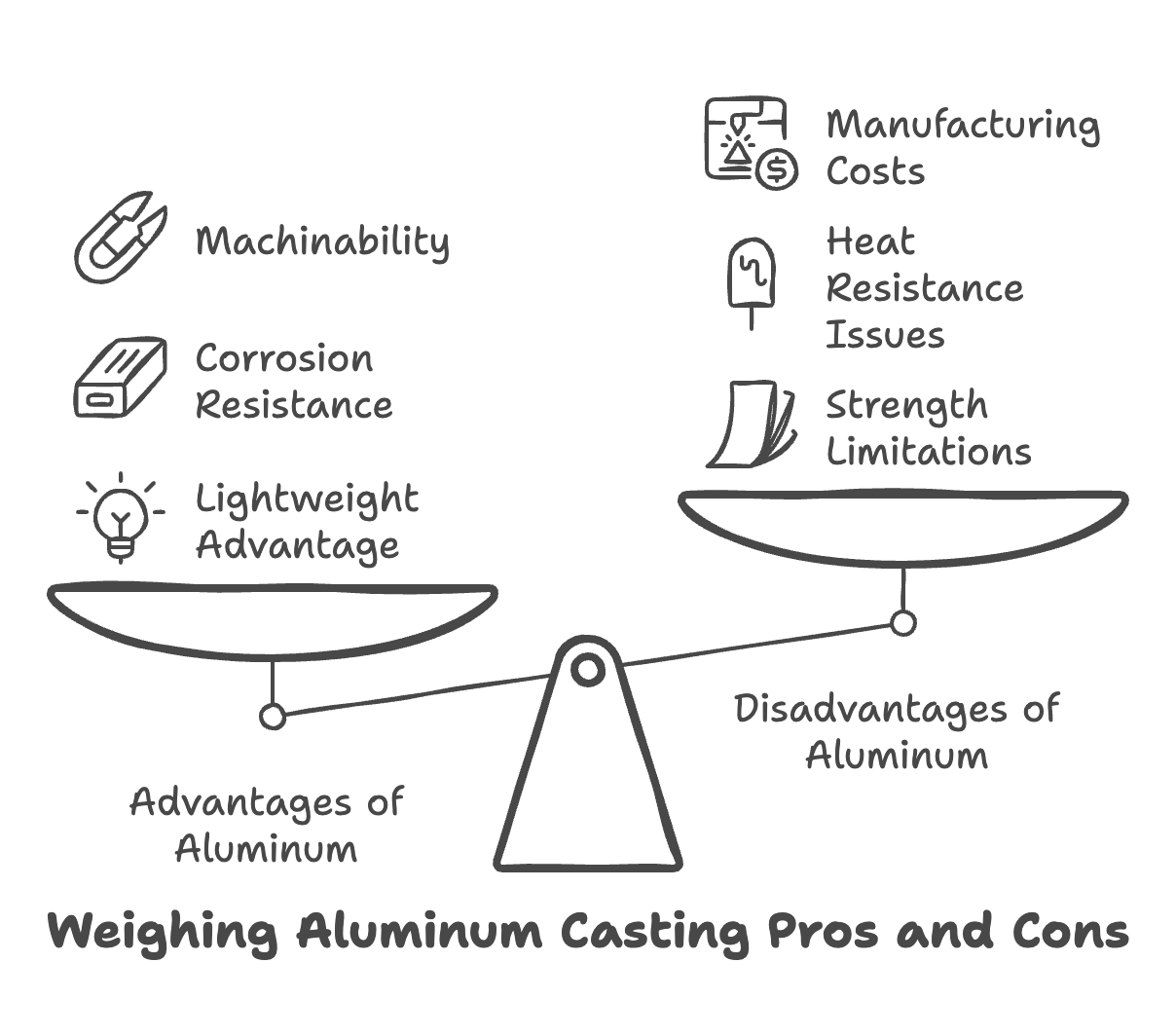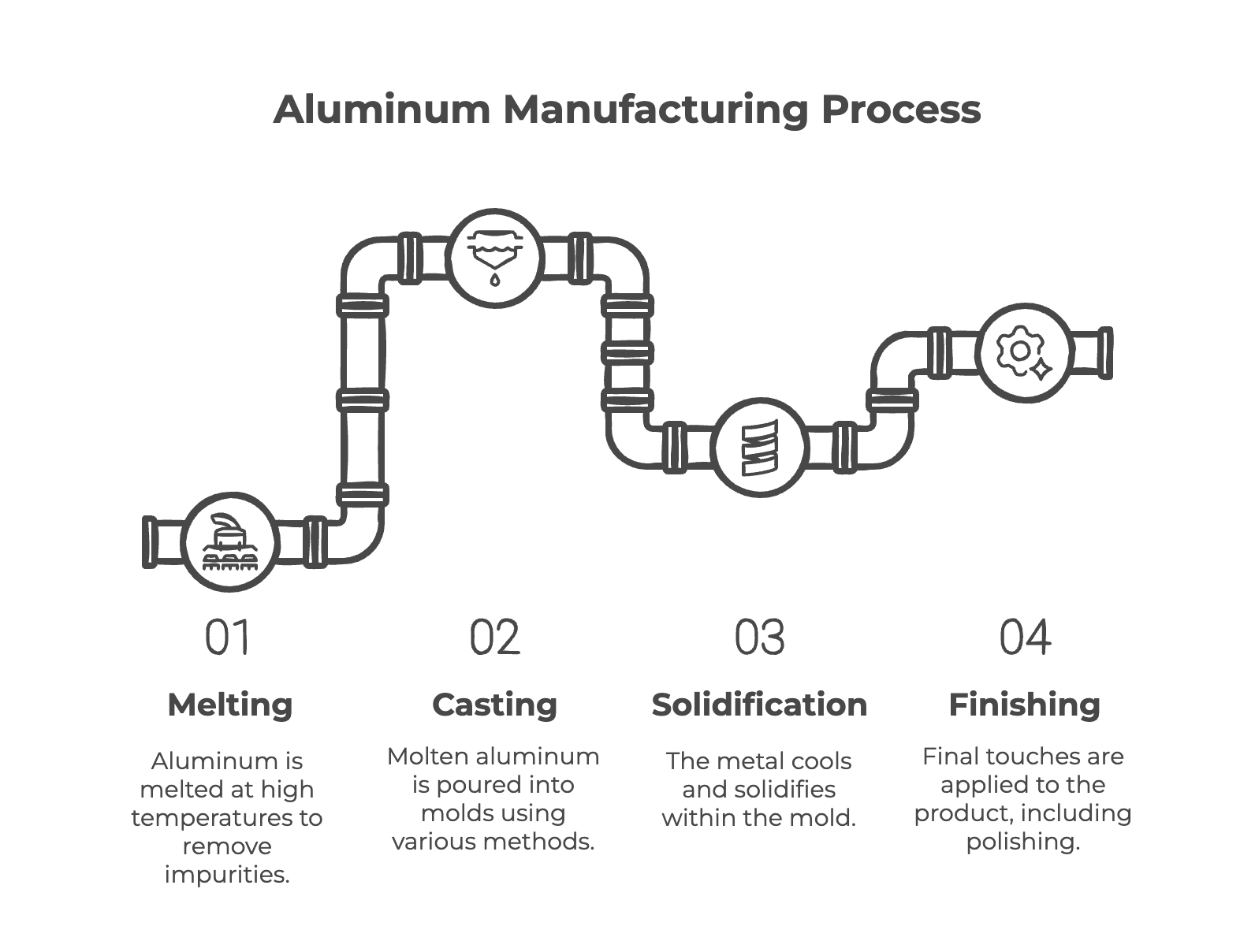◆Table of contents
ToggleIntroduction
This article provides a comprehensive explanation of aluminum castings. It covers fundamental knowledge, manufacturing processes, types, applications, and delves into quality control, costs, and environmental impact. We aim to answer all your “why” questions about aluminum castings.
In recent years, aluminum castings have garnered significant attention in industries like automotive. Their lightweight nature, high corrosion resistance, ability to handle complex shapes, and excellent recyclability make them a contributor to both high performance and a sustainable society. Let’s rediscover the allure of aluminum castings through this article.
What is Aluminum Casting?
Definition of Aluminum Casting
Aluminum casting is a product formed by pouring aluminum or an aluminum alloy into a mold. It is lightweight, highly corrosion-resistant, and easy to process, making it widely used in various fields such as automobiles, aircraft, and construction.
Differences from Other Metal Castings (Iron, Copper, etc.)
PropertyAluminum CastingIron CastingCopper CastingWeightLightweightHeavyHeavyCorrosion ResistanceExcellentPoor (prone to rust)ExcellentStrengthModerate (can be improved with alloys)HighHighHeat ResistanceModerateHighHighManufacturing CostModerateLowModerate
Advantages and Disadvantages of Aluminum Casting
Advantages: Lightweight, high corrosion resistance, machinability, recyclability, designability
Disadvantages: Strength and heat resistance limitations, manufacturing costs, casting defects, dimensional accuracy
Where Aluminum Castings Are Used
Aluminum products are used in a variety of fields such as automobiles (engine blocks, wheels), aircraft (structural materials), construction (exterior materials), industrial machinery, home appliances, medical equipment, and sporting goods.
Aluminum Casting Manufacturing Process
General Manufacturing Process of Aluminum Castings
The manufacturing of aluminum castings consists of four processes: melting, casting, solidification, and finishing. Managing each process is essential for manufacturing high-quality aluminum castings.
Detailed Steps of Each Process
- Melting: Aluminum or aluminum alloy is melted at 700-800°C. Impurities are removed and the composition is adjusted.
- Casting: The molten aluminum is poured into a mold. There are various methods such as gravity casting, low-pressure casting, and die casting.
- Solidification: Cooling and solidification occur within the mold. Controlling the solidification rate affects the quality.
- Finishing: The product is completed by removing burrs, polishing, and heat treatment.
Quality Control Points
Temperature control, solidification rate adjustment, and defect inspection are important. It is important to detect porosity and cracks early with X-ray inspection and ultrasonic inspection.
Latest Aluminum Casting Technology
Complex shapes and high quality are realized with 3D printing molds and vacuum casting technology. Expanding the possibilities of aluminum castings.
Types of Aluminum Castings
Representative Types of Aluminum Castings
Casting MethodCharacteristicsCostProduction VolumeAccuracySurface FinishManufacturing ProcessSand CastingSuitable for large and complex shapes, highly flexibleLow costSmall to large scale productionLowRoughInexpensive molds allow for flexible customizationDie CastingHigh precision, smooth surface finish, complex shapes, suitable for thin wallsHigh initial investmentMass productionHighSmoothHigh-speed, high-pressure injection with rapid solidification, high productivityLost-Wax CastingUltra-high precision, smooth surface finish, complex shapes, precision partsHigh costSmall to medium scale productionVery highSmooth-Gravity CastingLower cost than die casting, relatively high accuracyLow costMedium scale productionRelatively high(Not specified)-
There are various types of aluminum castings, including sand casting, die casting, lost-wax casting, and gravity casting.
Sand Casting
Cost-effective and suitable for large, complex shapes. Ideal for small to large-scale production, but the surface finish is rough.
Die Casting
Offers high precision, a smooth surface finish, and is perfect for complex shapes and thin walls. Best suited for mass production, but requires a high initial investment.
Lost-Wax Casting
Provides ultra-high precision and a smooth finish, making it suitable for complex shapes and precision parts. Ideal for small to medium-scale production, but comes at a higher cost.
Gravity Casting
A lower-cost alternative to die casting, offering relatively high accuracy. Suitable for medium-scale production.
Differences in Manufacturing Processes for Each Type
Die Casting: High-Pressure Casting
High-speed, high-pressure injection results in rapid solidification and high productivity.
Sand Casting: Low Cost and High Flexibility
Inexpensive molds allow for flexible customization.
Applications of Aluminum Castings
Aluminum castings are utilized in a wide range of fields, taking advantage of their lightweight nature, corrosion resistance, and ease of processing.
CategoryDescriptionAutomotive PartsEngine blocks, wheels, etc. Contribute to improved fuel efficiency through weight reduction.Aerospace ComponentsStructural materials, engine parts, etc. Achieve weight reduction and high strength.Construction MaterialsExterior materials, interior materials, sashes, etc. Excellent corrosion resistance and maintain a beautiful appearance.Other ApplicationsWind turbine parts (renewable energy), medical devices, etc.
Materials Used for Aluminum Castings: Points for Selecting the Optimal Aluminum Alloy
The material used for aluminum castings is aluminum alloy. By adding various elements to aluminum, it is possible to improve the required properties such as strength, corrosion resistance, and heat resistance. Selecting the appropriate aluminum alloy is an important factor that determines the quality of the aluminum casting.
Representative Aluminum Alloys and Their Properties
Alloy NameClassificationMain PropertiesMain ApplicationsA356Al-Si-Mg basedHigh castability, relatively high strength, corrosion resistanceAutomotive parts (cylinder heads, wheels, etc.), aircraft parts6061Al-Mg-Si basedBalance of strength and corrosion resistance, good weldabilityStructural materials, transportation equipment parts7075Al-Zn-Mg-Cu basedHighest strength among aluminum alloys, somewhat inferior corrosion resistance (requires surface treatment)Aircraft parts, sporting goods
How to Choose the Optimal Aluminum Alloy for Different Applications
PointDescriptionProduct ApplicationDifferent properties are required depending on the application, such as automotive parts, aircraft parts, or construction materials.Manufacturing MethodChoose an alloy suitable for the manufacturing method, such as sand casting, die casting, or lost-wax casting.CostConsider the cost, as material costs vary depending on the type of alloy.
Detailed Explanation of Each Alloy
A356: High Castability
- Properties: High fluidity when molten, excellent filling properties in molds. Suitable for complex shapes and thin-walled castings.
- Applications: Automotive parts (cylinder heads, wheels, etc.), aircraft parts.
6061: Balance of Strength and Corrosion Resistance
- Properties: Good balance of strength and corrosion resistance, good weldability. Suitable for a wide range of applications.
- Applications: Structural materials, transportation equipment parts.
7075: Highest Strength Among Aluminum Alloys
- Properties: Extremely high strength, but somewhat inferior corrosion resistance, requiring surface treatment.
- Applications: Aircraft parts, sporting goods.
When selecting an aluminum alloy for aluminum casting, it is important to comprehensively consider the three points of product application, manufacturing method, and cost to select the optimal alloy.
Quality Control of Aluminum Castings: Points for Ensuring High Quality
Aluminum castings play an important role in various industrial fields, so quality control is essential. Here, we will explain the important points in quality control of aluminum castings, the causes and countermeasures of defects, and inspection technologies.
Important Points in Quality Control: Preventing Three Types of Defects
Quality DefectCauseCountermeasuresPorosityGas entrapment during melting, shrinkage during solidificationDegassing treatment during melting, appropriate mold design, adjustment of solidification rateCracksThermal stress during solidification, restraint from the moldAppropriate mold design, adjustment of solidification rate, heat treatmentDeformationThermal stress during solidification, restraint from the moldAppropriate mold design, adjustment of solidification rate, heat treatment, machining
In quality control of aluminum castings, it is especially important to prevent the following three types of defects:
Porosity: Cause of Strength Reduction
Porosity refers to voids that occur inside the aluminum casting. It leads to a decrease in strength, so it is necessary to minimize its occurrence as much as possible.
Cracks: Cracks that Lead to Product Failure
Cracks refer to cracks that occur on the surface or inside the aluminum casting. It can lead to product failure and must never be allowed to occur.
Deformation: Dimensional Defect Leads to Performance Degradation
Deformation refers to the aluminum casting deviating from the designed shape. Dimensional defects can negatively affect the function and performance of the product.
Causes and Countermeasures of Defects: Thorough Investigation of Causes and Countermeasures
The above quality defects occur due to various causes.
- Porosity
- Cause: Gas entrapment during melting, shrinkage during solidification
- Countermeasures: Degassing treatment during melting, appropriate mold design, adjustment of solidification rate
- Cracks
- Cause: Thermal stress during solidification, restraint from the mold
- Countermeasures: Appropriate mold design, adjustment of solidification rate, heat treatment
- Deformation
- Cause: Thermal stress during solidification, restraint from the mold
- Countermeasures: Appropriate mold design, adjustment of solidification rate, heat treatment, machining
Inspection Technologies Used for Quality Control: Ensuring Quality with Non-Destructive Inspection
Various inspection technologies are used to ensure the quality of aluminum castings.
X-ray Inspection: Visualizing Internal Defects
X-ray inspection is used to detect defects (such as porosity and cracks) inside the aluminum casting.
Ultrasonic Inspection: Detecting Even Fine Defects
Ultrasonic inspection is used to detect defects (such as porosity and cracks) inside the aluminum casting. It is possible to detect fine defects that cannot be detected by X-ray inspection.
Dimensional Measurement: Guaranteeing Dimensions as Designed
Dimensional measurement is performed to confirm that the dimensions of the aluminum casting are finished as designed.
Visual Inspection: Checking for Scratches and Dirt on the Surface
Visual inspection is performed to check for scratches and dirt on the surface of the aluminum casting.
By thoroughly implementing these quality control measures, it is possible to provide high-quality aluminum castings.
Cost of Aluminum Castings: Three Points to Achieve Cost Reduction
The cost of aluminum castings is an important factor that affects the competitiveness of products. Here, we will explain the factors that affect the cost of aluminum castings and specific measures for cost reduction.
FactorDetailsCountermeasuresMaterial CostType of aluminum alloy, market price, amount usedUse of inexpensive alloys, use of recycled materialsManufacturing ProcessCasting method (sand casting, die casting, etc.), complexity of manufacturing processAdoption of efficient casting methods, review of manufacturing processQuantityUnit cost reduction due to mass production effectMass productionCost Reduction MeasuresReview of design (simplification of shape, reduction of wall thickness), selection of suppliers (price competition)
Factors Affecting Cost: Material Cost, Manufacturing Process, Quantity
The cost of aluminum castings varies mainly due to the following three factors.
Material Cost: Type and Price of Aluminum Alloy
The material cost varies greatly depending on the type of aluminum alloy used and the market price.
Manufacturing Process: Casting Method and Number of Processes
The cost differs depending on the casting method (sand casting, die casting, etc.) and the complexity of the manufacturing process.
Quantity: Cost Reduction due to Mass Production Effect
The more units produced, the lower the cost per unit.
Specific Measures for Cost Reduction: Design, Materials, Suppliers
The following measures are effective for reducing the cost of aluminum castings.
Review of Design: Reducing Material Costs by Adjusting Shape
Reduce material costs by simplifying the shape of the product or reducing the wall thickness.
Review of Materials: Utilizing Inexpensive Alloys and Recycled Materials
Consider changing to a less expensive aluminum alloy or using recycled materials.
Selection of Suppliers: Cost Reduction through Price Competition
Reduce costs by obtaining quotes from multiple suppliers and encouraging price competition.
Cost Advantages in Aluminum Casting in Vietnam: Labor Costs, Equipment Costs, Tax Incentives
Vietnam has relatively low labor and equipment costs, which can significantly reduce the cost of aluminum casting.
- Low Labor Costs: Manufacturing costs can be reduced because labor costs are significantly lower than in Japan and other developed countries.
- Low Equipment Costs: Initial investment can be reduced because equipment costs are relatively low compared to Japan and other developed countries.
- Tax Incentives: The Vietnamese government provides tax incentives for foreign companies.
However, when performing aluminum casting in Vietnam, it is necessary to pay attention to issues such as quality control and delivery management.
Environmental Impact of Aluminum Castings: Contributing to a Sustainable Society
While aluminum castings are used in various industries, the environmental impact during manufacturing is a challenge. Here, we will explain the environmental impact of aluminum castings and measures to reduce it.
Environmental Impact in the Manufacturing of Aluminum Castings: Energy Consumption, Greenhouse Gas, Waste
The main environmental impacts in the manufacturing of aluminum castings are the following three points:
- Energy Consumption: A large amount of energy is consumed for melting aluminum.
- Greenhouse Gas Emissions: CO2 and other gases are emitted during melting and electrolysis.
- Waste: Waste such as slag and mold sand is generated.
Measures to Reduce Environmental Impact: Recycling, Energy Saving, Waste Reduction
The following measures are effective to reduce the environmental impact of aluminum castings:
Improving the Recycling Rate: Effective Use of Resources
Using recycled aluminum significantly reduces energy consumption. It is important for the entire industry to work to improve the recycling rate.
Energy-Saving Technologies: High-Efficiency Melting Furnaces, Cold Box Method
Reduce energy consumption by improving the efficiency of melting furnaces and introducing energy-saving casting technologies.
Other Measures: Waste Reduction, LCA Implementation
Reduce environmental impact by reducing waste, using environmentally friendly materials, and implementing Life Cycle Assessment (LCA).
By comprehensively implementing these measures, aluminum castings can contribute to a sustainable society.
Summary
Importance and Future Prospects of Aluminum Castings
This article explained aluminum castings from their definition and manufacturing to their applications and environmental impact. Aluminum castings, which are lightweight, highly corrosion-resistant, easy to process, and readily recyclable, are indispensable materials in a wide range of fields such as automobiles, aircraft, and construction.1 With technological innovations such as 3D printing and vacuum casting, and the development of emerging countries such as Vietnam, aluminum castings will continue to contribute to a sustainable society in the future.


